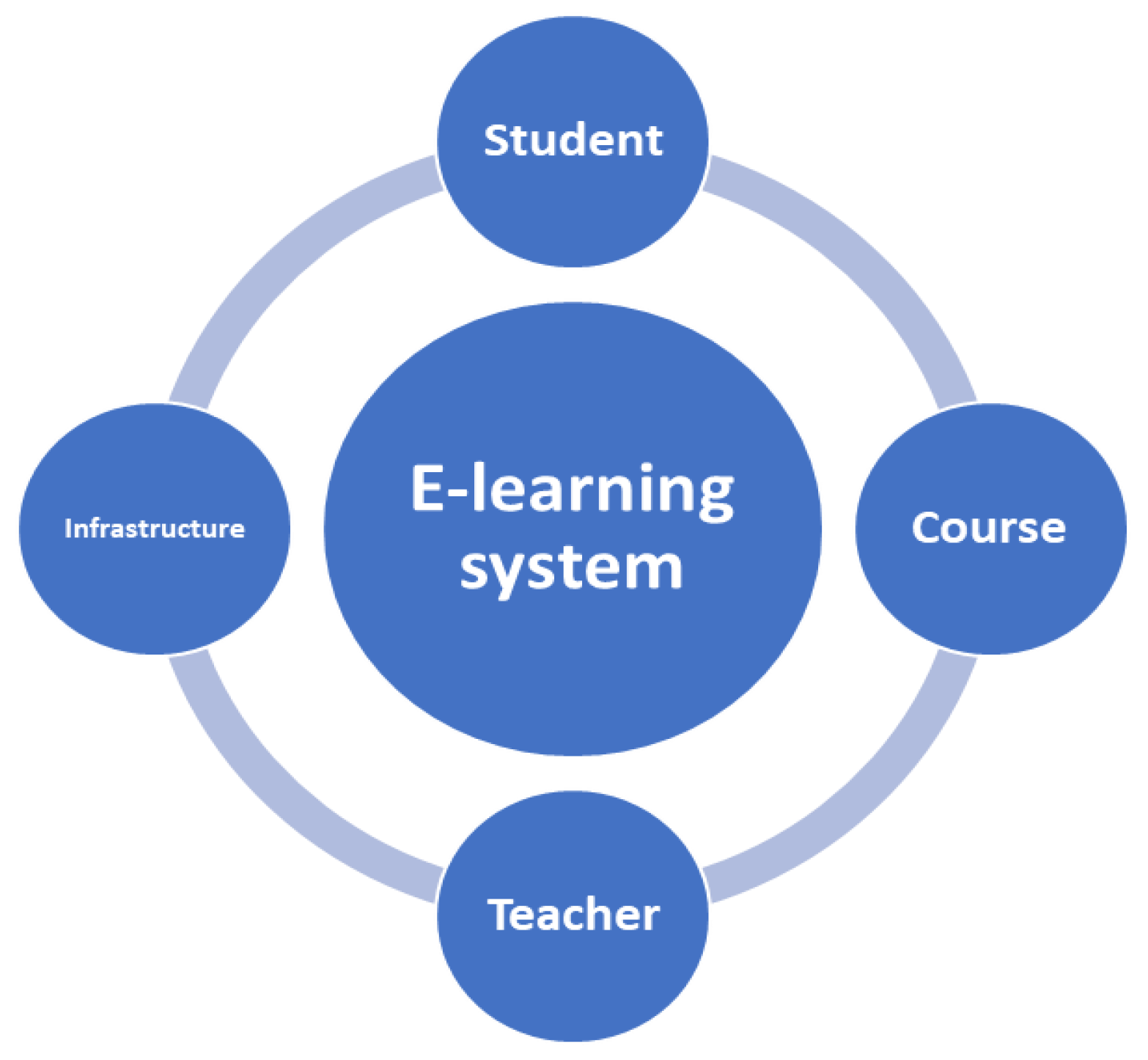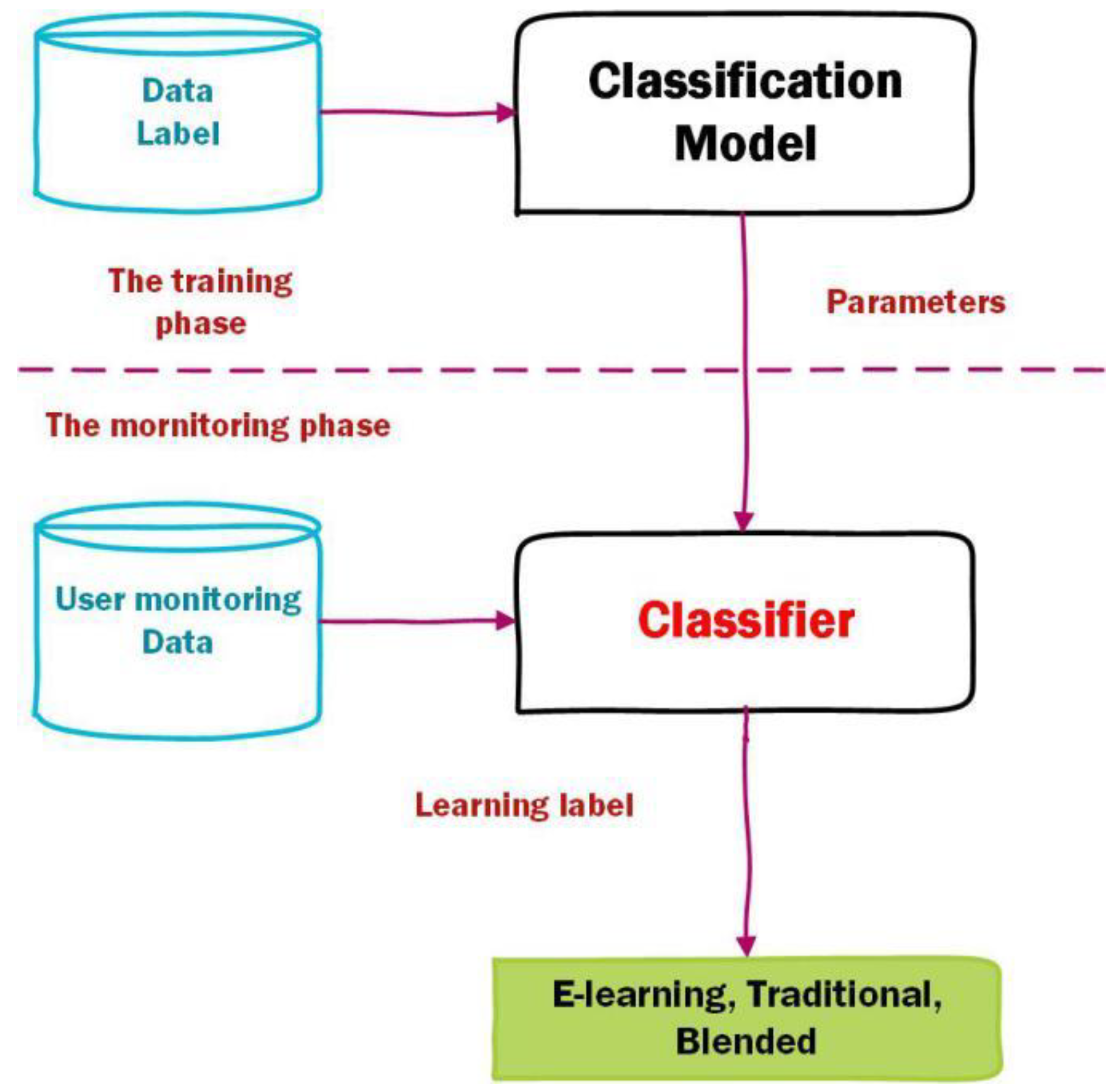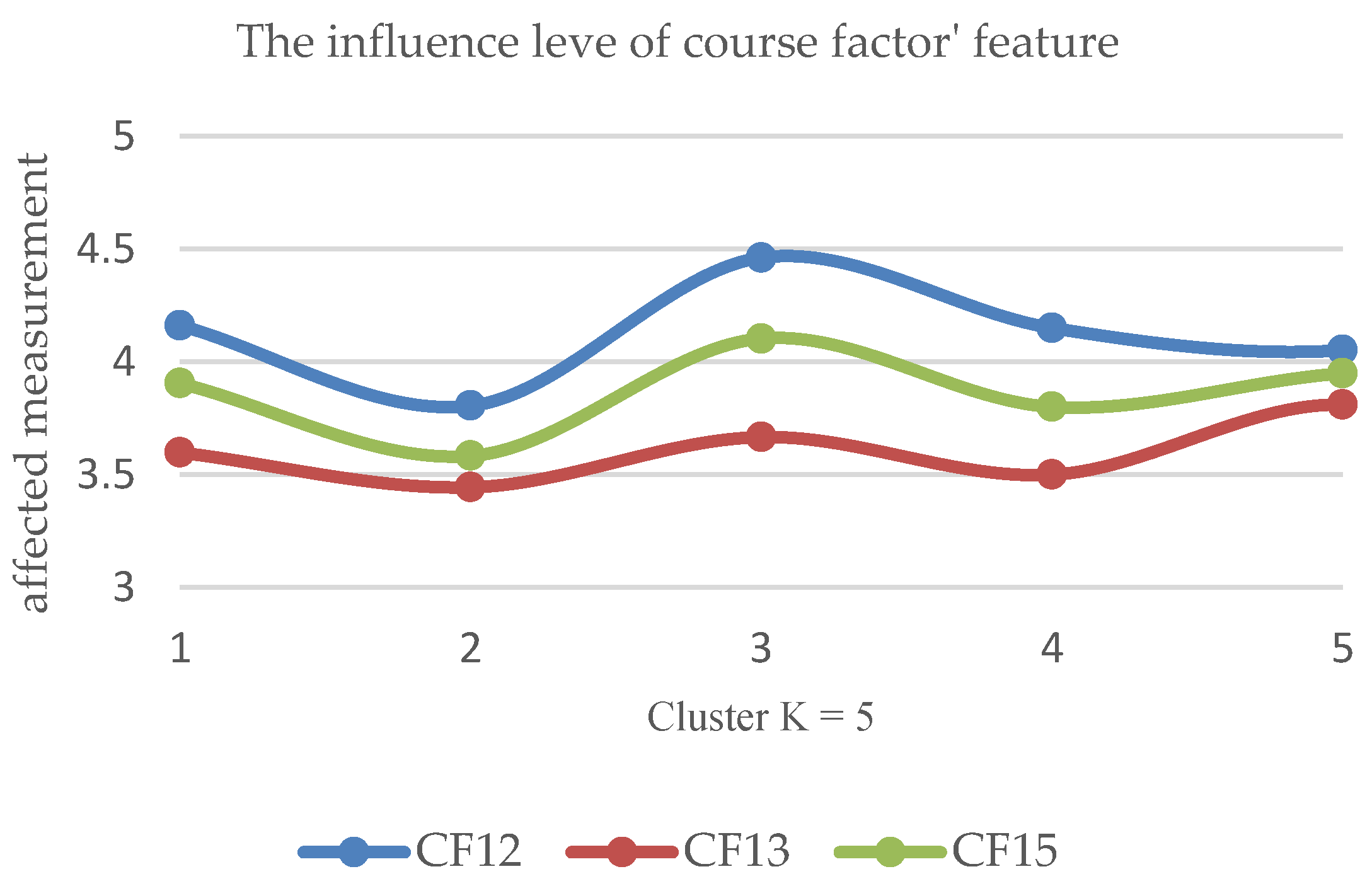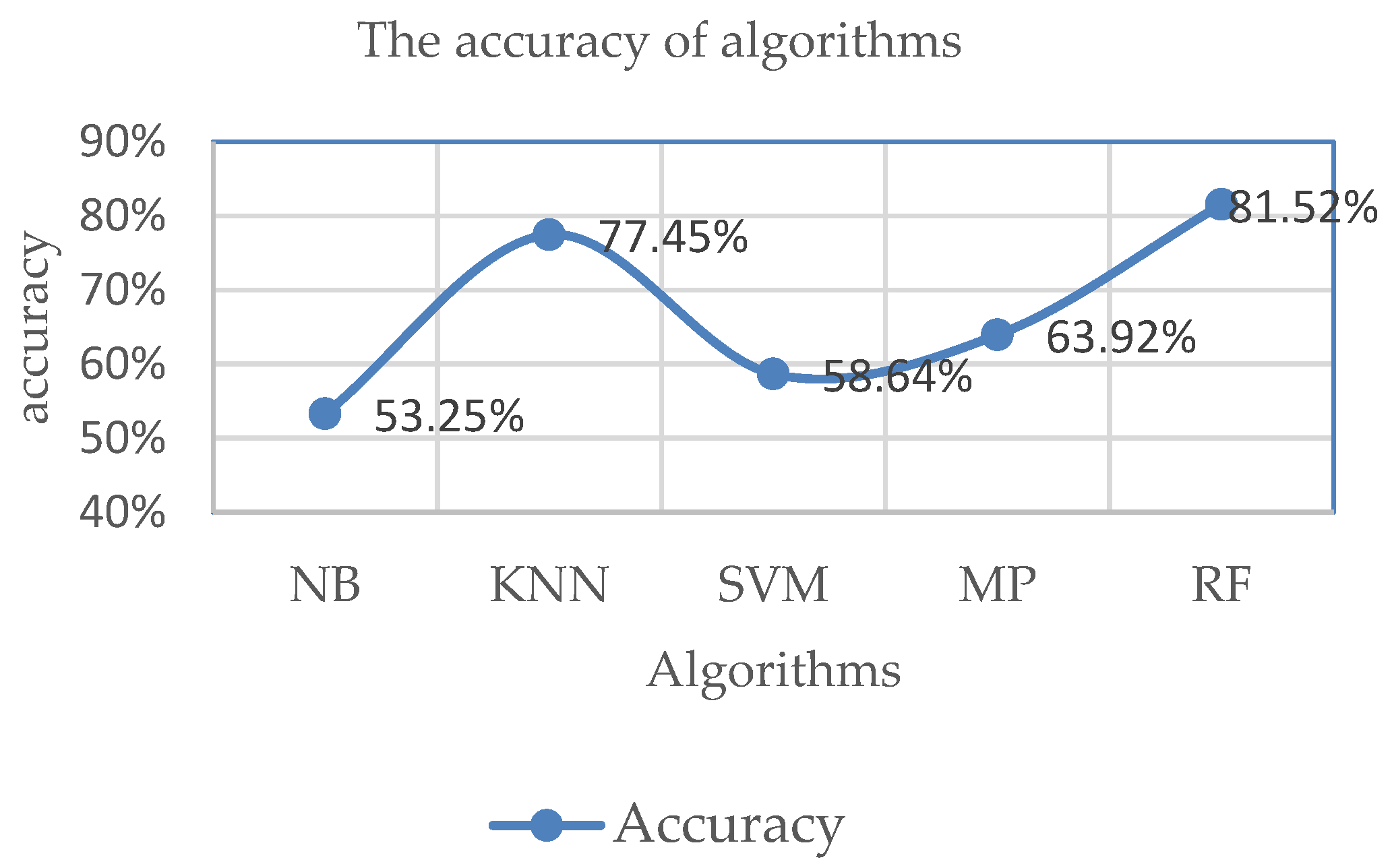The Factors Affecting Acceptance of E-Learning: A Machine Learning Algorithm Approach
Abstract
1. Introduction
2. Literature Review
2.1. Affected Factors
2.2. Artificial Intelligence Methodologies in Education
3. Evaluated E-Learning System Using Clustering Method
| Algorithm 1 calculated vector of influence factors |
| Initialization: D, a data set of N features. |
| 1. getting K, number of clusters [26] |
| 2. cluster D to K Cluster by K Mean |
| 3. calculated a Vector by Equation (1) |
| Return |
4. Studying Method Selection Model (SMSM)
4.1. Classifying Model
4.2. Algorithms and Evaluated Measurement
4.2.1. Algorithms
4.2.2. Evaluated Measurement
5. Experiment and Results
5.1. Data Collection
5.2. Environment
5.3. Experiment on EFM Result
5.4. Experiment on SMSM Result
5.5. Discussion
6. Conclusions and Future Work
Author Contributions
Funding
Conflicts of Interest
References
- World Health Organization. S. Report, “Coronavirus Disease”. Available online: https://www.who.int/docs/default-source/coronaviruse/situation-reports/20200811-covid-19-sitrep-204.pdf?sfvrsn=1f4383dd_2 (accessed on 11 August 2020).
- Chakraborty, I.; Maity, P. Science of the Total Environment COVID-19 outbreak: Migration, effects on society, global environment and prevention. Sci. Total Environ. 2020, 728, 138882. [Google Scholar] [CrossRef] [PubMed]
- Rapanta, C.; Botturi, L.; Goodyear, P.; Guàrdia, L. Online University Teaching During and after the Covid-19 Crisis: Refocusing Teacher Presence and Learning Activity. Postdigit. Sci. Educ. 2020, 1–23. [Google Scholar] [CrossRef]
- Leahy, S.M.; Holland, C.; Ward, F. The digital frontier: Envisioning future technologies impact on the classroom. Futures 2019, 113, 102422. [Google Scholar] [CrossRef]
- Salloum, S.A. Factors Affecting Students. In Acceptance of E-Learning System in Higher Education Using UTAUT and Structural Equation Modeling Approaches; Springer International Publishing: Berlin/Heidelberg, Germany, 2019; Volume 2. [Google Scholar]
- Saini, D.K.; Al-mamri, M.R.S. Social Sciences & Humanities Open Investigation of Technological Tools used in Education System in Oman. Soc. Sci. Humanit. Open 2019, 1, 100003. [Google Scholar]
- Keskin, S.; Yurdugül, H. “Factors Affecting Students’ Preferences For Online And Blended Learning: Motivational Vs. Cognitive. Eur. J. Open Distance E-Learn. 2019, 22, 73–86. [Google Scholar] [CrossRef]
- Martin, F.; Kumar, S. Frameworks for Assessing and Evaluating e-Learning Courses and Programs; Springer: Cham, Switzerland, 2018; pp. 271–280. [Google Scholar]
- Kabassi, K.; Dragonas, I.; Ntouzevits, A.; Pomonis, T.; Papastathopoulos, G. Evaluating a learning management system for blended learning in Greek higher education. Springerplus 2016, 5, 101. [Google Scholar] [CrossRef] [PubMed]
- Ghosh, S. An Approach to Building a Learning Management System that Emphasizes on Incorporating Individualized Dissemination with Intelligent Tutoring. J. Inst. Eng. Ser. B 2016, 98, 1–8. [Google Scholar] [CrossRef]
- Hasan, H.M.R. Machine Learning A lgorithm for Student ’ s Performance Prediction. In Proceedings of the 2019 10th International Conference on Computing, Communication and Networking Technologies (ICCCNT), Kanpur, India, 6–8 July 2019; Volume 201, pp. 1–7. [Google Scholar]
- Fachantidis, A.; Taylor, M.; Vlahavas, I. Learning to Teach Reinforcement Learning Agents. Mach. Learn. Knowl. Extr. 2017, 1, 21–42. [Google Scholar] [CrossRef]
- Basak, S.K.; Wotto, M.; Bélanger, P. International j ournal of e ngineering s ciences & m anagement r esearch factors affecting to e-learning in continuing education in africa: A review of literature. Int. J. Eng. Sci. Manag. Res. 2017, 4, 86–97. [Google Scholar]
- Monem, A.A.; Shaalan, K. Exploring Students. In Acceptance of E-Learning Through the Development of a Comprehensive Technology Acceptance Model; IEEE Access: Piscataway, NJ, USA, 2019; Volume 7, pp. 128445–128462. [Google Scholar] [CrossRef]
- Rivas, A.; González-briones, A.; Hernández, G.; Prieto, J.; Chamoso, P. Neurocomputing Artificial neural network analysis of the academic performance of students in virtual learning environments. Neurocomputing 2020. [Google Scholar] [CrossRef]
- Gamage, D.; Fernando, S. Factors affecting to effective eLearning: Learners Perspective. Sci. Res. J. 2014, 2, 42–48. [Google Scholar]
- Azizi, S.M.; Khatony, A. Investigating factors affecting on medical sciences students’ intention to adopt mobile learning. BMC Med Educ. 2019, 19, 381. [Google Scholar] [CrossRef] [PubMed]
- Choi, C.; Jeong, H. Quality Evaluation for Multimedia Contents of E-Learning Systems Using the ANP Approach on High Speed Network. Multimed. Tools Appl. 2019, 78, 28853–28875. [Google Scholar] [CrossRef]
- Kose, U.; Koc, D. Artificial Intelligence Applications in Distance Education; IGI Global: Herseys, PA, USA, 2014. [Google Scholar]
- Vitolina, I. E-inclusion Modeling for Blended e-learning Course. Procedia Procedia Comput. Sci. 2015, 65, 744–753. [Google Scholar] [CrossRef]
- Almasri, A.; Alkhawaldeh, R.S. Clustering-Based EMT Model for Predicting Student Performance. Arab. J. Sci. Eng. 2020. [Google Scholar] [CrossRef]
- Pasina, I.; Bayram, G.; Labib, W.; Abdelhadi, A.; Nurunnabi, M. MethodsX Clustering students into groups according to their learning style. MethodsX 2019, 6, 2189–2197. [Google Scholar] [CrossRef] [PubMed]
- Jin, X.; Han, J. K-Medoids Clustering. Encyclopedia of Machine Learning and Data Mining; Springer: Boston, MA, USA, 2017; pp. 563–565. [Google Scholar] [CrossRef]
- Lu, D.; Nguyen, D.; Nguyen, T. Vehicle mode and driving activity detection based on analyzing sensor data of smartphones. Sensors 2018, 18, 1036. [Google Scholar] [CrossRef] [PubMed]
- Nguyen, T.; Lu, D.; Nguyen, D.; Nguyen, H. Abnormal Driving Pattern Detection Using Smartphone Sensors. Electronics 2020, 9, 217. [Google Scholar] [CrossRef]
- Patil, C.; Baidari, I. Estimating the Optimal Number of Clusters k in a Dataset Using Data Depth. Data Sci. Eng. 2019, 4, 132–140. [Google Scholar] [CrossRef]
- Bouckaert, R.R.; Frank, E.; Kirkby, R.; Reutemann, P.; Seewald, A.; Scuse, D. WEKA Manual for Version 3-7-8; 21 January 2013; Available online: https://statweb.stanford.edu/~lpekelis/13_datafest_cart/WekaManual-3-7-8.pdf (accessed on 11 August 2020).







| Research | Factors/Attributes/Features | Method/Measurement/Tools |
|---|---|---|
| Alberto Rivas et al. [15] (2020) | Course viewed, Course module viewed, Discussion viewed, Course module instance list viewed, The status of the submission has been viewed, A submission has been submitted, Summary of the questionnaire attempt, Attempted visualized questionnaire, The attempt has begun, Attempt sent, Grade user report viewed, Course user report seen | Decision tree/Random forest Extreme gradient boosting/Multilayer perceptron |
| Said A.salloum et al. [14] (2019) | Content quality, information quality, and system quality, Self-efficacy, Subjective norm, enjoyment, accessibility, playfulness, ease of use, usefulness, Attitude towards use, behavioral intention | Statistics/Convergent validity, Discriminant validity measurement/SmartPLS 3.2.7 tool |
| Seyyed Mohsen Azizi et al. [17] (2019) | Attitude, Subject Norm, Behavioral Control, attitudinal beliefs, normative beliefs, and control beliefs, Ease of Use, Usefulness | Statistics/Convergent validity, Discriminant validity measurement/SmartPLS 3.2.7 tool |
| Sinan Keskin et al. [7] (2019) | Learning Environment Preferences, Self-directed learning, Learner control, Motivation towards e-learning, Rehearsal, Organization, Elaboration, Test anxiety, Task value, Self-efficacy | Non-linear correlation between the variables/OVERALS analysis tool in SPSS 21 |
| Cheol-Rim Choi et al. [18] (2019) | System quality, Information quality, Service quality, Attractiveness, | Weights of the quality attributes/ANP |
| F. Martin et al. [8] (2018) | Institutional Support, Technology Infrastructure, Course Design, Learner and Instructor Support, Course Assessment and Evaluation, Learning effectiveness, Faculty and Student Satisfaction | overview |
| Sujit Kumar Basa et al. [13] (2017) | institutional, technical, resource, training, competency, infrastructural, attitudinal and social integration | Technology Acceptance Model/Theory of Planned Behavior |
| Katerina Kabassi et al. [9] (2016) | Student, Teacher, Design, Courses, Environment, Technology | Statistical |
| Dilrukshi Gamage et al. [16] (2014) | Technology, Pedagogy, Motivation, Usability, Content/Material, Support for Learners, Assessment, Future Directions, Collaboration, Interactivity Does | Statistical/SPSS |
| Alan Y.K. Chan et al. [8] (2003) | online courses, learning effectiveness, evaluation methods and evaluation results | Web Mining techniques |
| Category | Feature | Illustration |
|---|---|---|
| Student | SF1 | Year of birth |
| SF2 | Gender | |
| SF3 | Place of residence | |
| SF4 | Year of grade | |
| SF5 | Field of studying | |
| SF6 | Average of outcome | |
| Teacher | TF7 | Influence of teacher |
| Infrastructure | IF8 | Preparing lecture and material |
| IF9 | Hardware, internet quality | |
| IF10 | Influence of learning management system (LMS) and storage service | |
| IF11 | Influence of regulation environment | |
| Courses | CF12 | Suitableness of course in e-learning |
| CF13 | Effect of e-learning method | |
| CF14 | Level of course | |
| CF15 | Influence of assessment | |
| CF16 | Learning methods |
| Category | Feature | Clustering | Classifying |
|---|---|---|---|
| Student | SF1 | Integer | Integer |
| SF2 | Male; Female | 1, 0 | |
| SF3 | City, Province, other | 3, 2, 1 | |
| SF4 | Grade: 1, 2, 3,4 | 1, 2, 3, 4 | |
| SF5 | Journalistic and publication, political, other | 3, 2, 1 | |
| SF6 | A, B, C, D, E | 4, 3, 2, 1 | |
| Teacher | TF7 | Five likert scale | 1, …, 5 |
| Infrastructure | IF8 | Five likert scale | 1, …, 5 |
| IF9 | Five likert scale | 1, …, 5 | |
| IF10 | Five likert scale | 1, …, 5 | |
| IF11 | Five likert scale | 1, …, 5 | |
| Courses | CF12 | Five likert scale | 1, …, 5 |
| CF13 | Five likert scale | 1, …, 5 | |
| CF14 | Knowledge, basic, field | 1, 2, 3 | |
| CF15 | Five likert scale | 1, …, 5 | |
| CF16-label | e-learning, traditional, blended | E, T, B |
| SF | General | C1 17% | C2 18% | C3 13% | C4 36% | C5 16% |
|---|---|---|---|---|---|---|
| SF1 | 19.7387 | 20 | 19.1282 | 20.85 | 20.1207 | 19.087 |
| SF2 | Female | Female | Female | Female | Female | Female |
| SF3 | City | Other | City | City | City | City |
| SF4 | Grade2 | Grade2 | Grade1 | Grade3 | Grade2 | Grade1 |
| SF5 | Other | Political | Other | Political | Journal | Other |
| SF6 | B | C | C | B | B | B |
| TF7 | 3.9899 | 3.8056 | 4.1026 | 3.5 | 4.1207 | 4.087 |
| IF8 | 4.2663 | 3.9167 | 4.3333 | 4.2 | 4.3448 | 4.413 |
| IF9 | 4.608 | 4.4444 | 4.7949 | 4.5 | 4.6034 | 4.6304 |
| IF10 | 4.2513 | 4.0833 | 4.4872 | 4.2 | 4.2069 | 4.2609 |
| IF11 | 3.7273 | 3.3889 | 4.0256 | 3.45 | 3.7539 | 3.8261 |
| CF12 | 4.1608 | 3.8056 | 4.4615 | 4.15 | 4.0517 | 4.3261 |
| CF13 | 3.598 | 3.4444 | 3.6667 | 3.5 | 3.8103 | 3.4348 |
| CF14 | Basic | Basic | Knowledge | Field | Basic | Knowledge |
| CF15 | 3.9045 | 3.5833 | 4.1026 | 3.8 | 3.9483 | 3.9783 |
| Method | Blended | Blended | Blended | Blended | E-Learning | Blended |
| Algorithm | Accuracy | Precision | Recall | F1 | ROC |
|---|---|---|---|---|---|
| NB | 53.25% | 0.491 | 0.532 | 0.497 | 0.607 |
| KNN | 77.45% | 0.772 | 0.774 | 0.773 | 0.796 |
| SVM | 58.64% | 0.759 | 0.586 | 0.44 | 0.508 |
| MP | 63.92% | 0.63 | 0.639 | 0.629 | 0.719 |
| RF | 81.52% | 0.813 | 0.815 | 0.812 | 0.911 |
| Model/System | Feature | Algorithm | Accuracy |
|---|---|---|---|
| System in [15] | 5 type of events/39 features | DT | 70.5% |
| RF | 78.1% | ||
| EGB | 76.5% | ||
| MP | 78.2% | ||
| SMSM | 4 type factor/16 features | RF | 81.52% |
© 2020 by the authors. Licensee MDPI, Basel, Switzerland. This article is an open access article distributed under the terms and conditions of the Creative Commons Attribution (CC BY) license (http://creativecommons.org/licenses/by/4.0/).
Share and Cite
Lu, D.-N.; Le, H.-Q.; Vu, T.-H. The Factors Affecting Acceptance of E-Learning: A Machine Learning Algorithm Approach. Educ. Sci. 2020, 10, 270. https://doi.org/10.3390/educsci10100270
Lu D-N, Le H-Q, Vu T-H. The Factors Affecting Acceptance of E-Learning: A Machine Learning Algorithm Approach. Education Sciences. 2020; 10(10):270. https://doi.org/10.3390/educsci10100270
Chicago/Turabian StyleLu, Dang-Nhac, Hong-Quang Le, and Tuan-Ha Vu. 2020. "The Factors Affecting Acceptance of E-Learning: A Machine Learning Algorithm Approach" Education Sciences 10, no. 10: 270. https://doi.org/10.3390/educsci10100270
APA StyleLu, D.-N., Le, H.-Q., & Vu, T.-H. (2020). The Factors Affecting Acceptance of E-Learning: A Machine Learning Algorithm Approach. Education Sciences, 10(10), 270. https://doi.org/10.3390/educsci10100270





